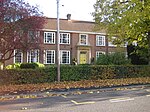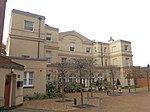Bourne Wood

Bourne Wood (also known as Bourne Woods) is an area of predominantly coniferous woodland just south of Farnham, Surrey, England; the area is often used as a film location. Near to another area also used as a film location (Hankley Common in Elstead), locally it was known as The Clumps, and was called this until Forestry England changed the name in the 1950s when fire breaks were introduced. Charles Darwin may have written about the area in Appendices of Natural Selection, describing the trees in clumps. A promontory (rise) above a large heathland clearing (used for the filming of Gladiator) provides views over the surrounding woodland. Much of the wood was formerly heathland at the western end of the Greensand Ridge that was developed privately during the 20th century as commercial conifer plantations. This part of the wood has been purchased by the Royal Society for the Protection of Birds and is being restored mainly to heath, with retention of some woodland of wildlife significance, as Farnham Heath nature reserve. Their aim is to benefit scarce heathland species such as nightjar, woodlark, Dartford warbler and tree pipit as well as species such as sand lizard.
Excerpt from the Wikipedia article Bourne Wood (License: CC BY-SA 3.0, Authors, Images).Bourne Wood
Marjorie's Path, Waverley
Geographical coordinates (GPS) Address External links Nearby Places Show on map
Geographical coordinates (GPS)
| Latitude | Longitude |
|---|---|
| N 51.191 ° | E -0.778 ° |
Address
Bourne Wood
Marjorie's Path
GU10 3RH Waverley
England, United Kingdom
Open on Google Maps









